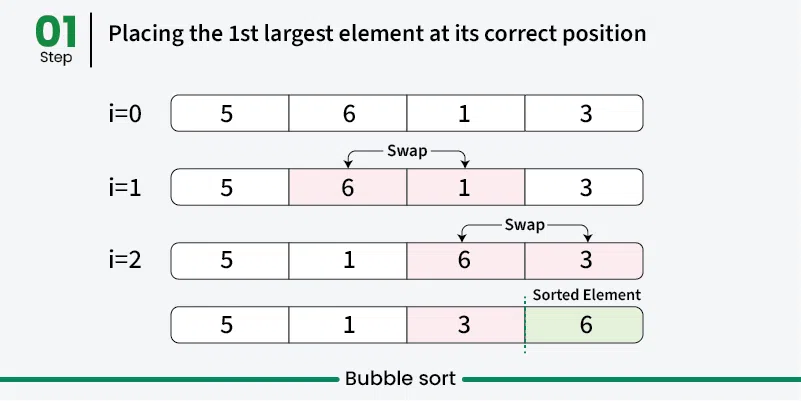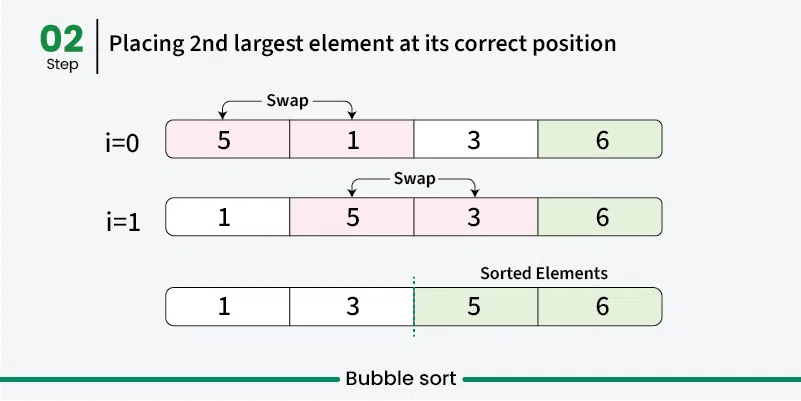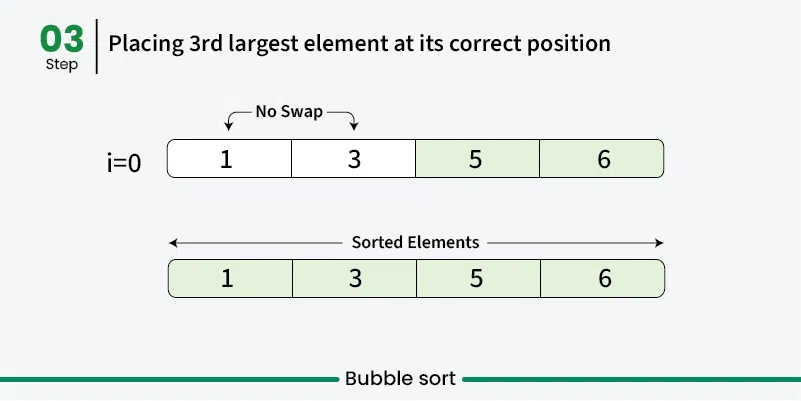Bubble Sort Algorithm
Last Updated :
21 Jan, 2025
Improve
Try it on GfG Practice 

Bubble Sort is the simplest sorting algorithm that works by repeatedly swapping the adjacent elements if they are in the wrong order. This algorithm is not suitable for large data sets as its average and worst-case time complexity are quite high.
- We sort the array using multiple passes. After the first pass, the maximum element goes to end (its correct position). Same way, after second pass, the second largest element goes to second last position and so on.
- In every pass, we process only those elements that have already not moved to correct position. After k passes, the largest k elements must have been moved to the last k positions.
- In a pass, we consider remaining elements and compare all adjacent and swap if larger element is before a smaller element. If we keep doing this, we get the largest (among the remaining elements) at its correct position.
How does Bubble Sort Work?






Below is the implementation of the bubble sort. It can be optimized by stopping the algorithm if the inner loop didn’t cause any swap.
#include <bits/stdc++.h>
using namespace std;
// An optimized version of Bubble Sort
void bubbleSort(vector<int>& arr) {
int n = arr.size();
bool swapped;
for (int i = 0; i < n - 1; i++) {
swapped = false;
for (int j = 0; j < n - i - 1; j++) {
if (arr[j] > arr[j + 1]) {
swap(arr[j], arr[j + 1]);
swapped = true;
}
}
// If no two elements were swapped, then break
if (!swapped)
break;
}
}
// Function to print a vector
void printVector(const vector<int>& arr) {
for (int num : arr)
cout << " " << num;
}
int main() {
vector<int> arr = { 64, 34, 25, 12, 22, 11, 90 };
bubbleSort(arr);
cout << "Sorted array: \n";
printVector(arr);
return 0;
}
// Optimized implementation of Bubble sort
#include <stdbool.h>
#include <stdio.h>
void swap(int* xp, int* yp){
int temp = *xp;
*xp = *yp;
*yp = temp;
}
// An optimized version of Bubble Sort
void bubbleSort(int arr[], int n){
int i, j;
bool swapped;
for (i = 0; i < n - 1; i++) {
swapped = false;
for (j = 0; j < n - i - 1; j++) {
if (arr[j] > arr[j + 1]) {
swap(&arr[j], &arr[j + 1]);
swapped = true;
}
}
// If no two elements were swapped by inner loop,
// then break
if (swapped == false)
break;
}
}
// Function to print an array
void printArray(int arr[], int size){
int i;
for (i = 0; i < size; i++)
printf("%d ", arr[i]);
}
int main(){
int arr[] = { 64, 34, 25, 12, 22, 11, 90 };
int n = sizeof(arr) / sizeof(arr[0]);
bubbleSort(arr, n);
printf("Sorted array: \n");
printArray(arr, n);
return 0;
}
// Optimized java implementation of Bubble sort
import java.io.*;
class GFG {
// An optimized version of Bubble Sort
static void bubbleSort(int arr[], int n){
int i, j, temp;
boolean swapped;
for (i = 0; i < n - 1; i++) {
swapped = false;
for (j = 0; j < n - i - 1; j++) {
if (arr[j] > arr[j + 1]) {
// Swap arr[j] and arr[j+1]
temp = arr[j];
arr[j] = arr[j + 1];
arr[j + 1] = temp;
swapped = true;
}
}
// If no two elements were
// swapped by inner loop, then break
if (swapped == false)
break;
}
}
// Function to print an array
static void printArray(int arr[], int size){
int i;
for (i = 0; i < size; i++)
System.out.print(arr[i] + " ");
System.out.println();
}
// Driver program
public static void main(String args[]){
int arr[] = { 64, 34, 25, 12, 22, 11, 90 };
int n = arr.length;
bubbleSort(arr, n);
System.out.println("Sorted array: ");
printArray(arr, n);
}
}
# Optimized Python program for implementation of Bubble Sort
def bubbleSort(arr):
n = len(arr)
# Traverse through all array elements
for i in range(n):
swapped = False
# Last i elements are already in place
for j in range(0, n-i-1):
# Traverse the array from 0 to n-i-1
# Swap if the element found is greater
# than the next element
if arr[j] > arr[j+1]:
arr[j], arr[j+1] = arr[j+1], arr[j]
swapped = True
if (swapped == False):
break
# Driver code to test above
if __name__ == "__main__":
arr = [64, 34, 25, 12, 22, 11, 90]
bubbleSort(arr)
print("Sorted array:")
for i in range(len(arr)):
print("%d" % arr[i], end=" ")
// Optimized C# implementation of Bubble sort
using System;
class GFG {
// An optimized version of Bubble Sort
static void bubbleSort(int[] arr, int n){
int i, j, temp;
bool swapped;
for (i = 0; i < n - 1; i++) {
swapped = false;
for (j = 0; j < n - i - 1; j++) {
if (arr[j] > arr[j + 1]) {
// Swap arr[j] and arr[j+1]
temp = arr[j];
arr[j] = arr[j + 1];
arr[j + 1] = temp;
swapped = true;
}
}
// If no two elements were
// swapped by inner loop, then break
if (swapped == false)
break;
}
}
// Function to print an array
static void printArray(int[] arr, int size){
int i;
for (i = 0; i < size; i++)
Console.Write(arr[i] + " ");
Console.WriteLine();
}
// Driver method
public static void Main(){
int[] arr = { 64, 34, 25, 12, 22, 11, 90 };
int n = arr.Length;
bubbleSort(arr, n);
Console.WriteLine("Sorted array:");
printArray(arr, n);
}
}
// Optimized javaScript implementation
// of Bubble sort
function bubbleSort(arr, n){
var i, j, temp;
var swapped;
for (i = 0; i < n - 1; i++){
swapped = false;
for (j = 0; j < n - i - 1; j++){
if (arr[j] > arr[j + 1])
{
// Swap arr[j] and arr[j+1]
temp = arr[j];
arr[j] = arr[j + 1];
arr[j + 1] = temp;
swapped = true;
}
}
// IF no two elements were
// swapped by inner loop, then break
if (swapped == false)
break;
}
}
// Function to print an array
function printArray(arr, size){
var i;
for (i = 0; i < size; i++)
console.log(arr[i] + " ");
}
// Driver program
var arr = [ 64, 34, 25, 12, 22, 11, 90 ];
var n = arr.length;
bubbleSort(arr, n);
console.log("Sorted array: ");
printArray(arr, n);
<?php
// PHP Optimized implementation
// of Bubble sort
function bubbleSort(&$arr)
{
$n = sizeof($arr);
// Traverse through all array elements
for($i = 0; $i < $n; $i++)
{
$swapped = False;
// Last i elements are already
// in place
for ($j = 0; $j < $n - $i - 1; $j++)
{
// Traverse the array from 0 to
// n-i-1. Swap if the element
// found is greater than the
// next element
if ($arr[$j] > $arr[$j+1])
{
$t = $arr[$j];
$arr[$j] = $arr[$j+1];
$arr[$j+1] = $t;
$swapped = True;
}
}
// If no two elements were swapped
// by inner loop, then break
if ($swapped == False)
break;
}
}
// Driver code
$arr = array(64, 34, 25, 12, 22, 11, 90);
$len = sizeof($arr);
bubbleSort($arr);
echo "Sorted array: \n";
for($i = 0; $i < $len; $i++)
echo $arr[$i]." ";
// This code is contributed by ChitraNayal.
?>
Output
Sorted array: 11 12 22 25 34 64 90
Complexity Analysis of Bubble Sort:
Time Complexity: O(n2)
Auxiliary Space: O(1)
Please refer Complexity Analysis of Bubble Sort for details.
Advantages of Bubble Sort:
- Bubble sort is easy to understand and implement.
- It does not require any additional memory space.
- It is a stable sorting algorithm, meaning that elements with the same key value maintain their relative order in the sorted output.
Disadvantages of Bubble Sort:
- Bubble sort has a time complexity of O(n2) which makes it very slow for large data sets.
- Bubble sort has almost no or limited real world applications. It is mostly used in academics to teach different ways of sorting.
- Recursive Bubble Sort
- Coding practice for sorting
- Quiz on Bubble Sort
- Complexity Analysis of Bubble Sort

